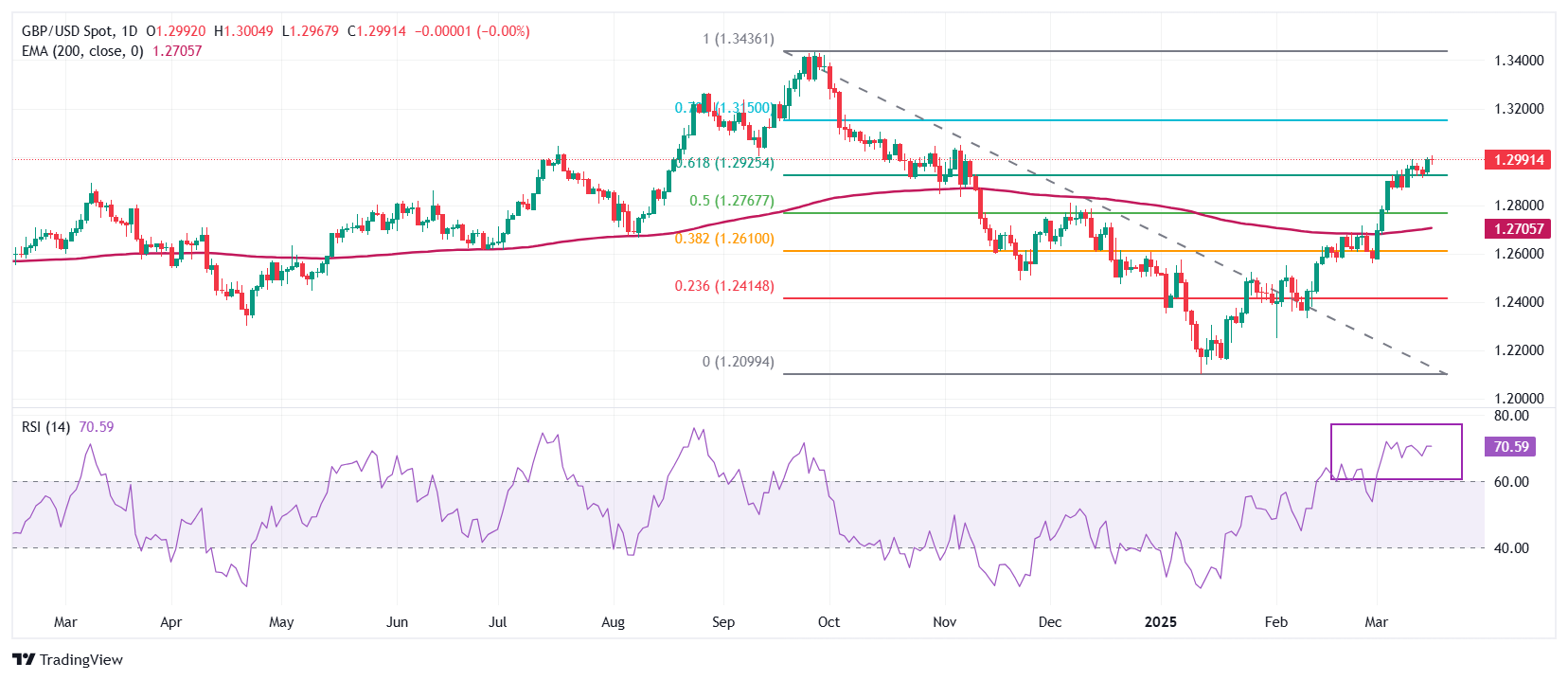- The Pound Sterling drops from 1.3000 against the US Dollar as the DXY Index finds bids near the five-month.
- Fed officials could project a higher number of interest rate cuts this year.
- The Fed and the BoE are expected to keep interest rates steady on Wednesday and Thursday, respectively.
The Pound Sterling (GBP) faces slight selling pressure near the psychological figure of 1.3000 against the US Dollar (USD) in North American trading hours on Tuesday. The GBP/USD pair struggles to extend its upside as the US Dollar Index (DXY), which tracks the Greenback’s value against six major currencies, finds buying interest near the five-month low of 103.20.
The Greenback rebounds investors turn cautious ahead of the Federal Reserve (Fed) monetary policy outcome on Wednesday. Investors will pay close attention to Fed's dot plot, which shows where officials see Federal Fund rates heading in the near and longer term, as the central bank is certain to keep interest rates steady in the range of 4.25%-4.50% for the second time in a row.
Fed could guide more interest rate cuts this year when they end the March policy meeting on Wednesday. In December, Fed officials collectively guided two interest rate cuts in 2025. Market expectations that the central bank could turn slightly dovish on the monetary policy outlook are based on easing inflationary pressures and deteriorating consumer confidence.
The United States (US) Consumer Price Index (CPI) data for February showed that the core inflation – which excludes volatile food and energy prices – rose by 3.1%, the lowest level seen since April 2021. Meanwhile, the preliminary Michigan Consumer Sentiment Index fell significantly lower at 57.9 in March against estimates of 63.1 and the former reading of 64.7.
British Pound PRICE Today
The table below shows the percentage change of British Pound (GBP) against listed major currencies today. British Pound was the strongest against the Australian Dollar.
| USD | EUR | GBP | JPY | CAD | AUD | NZD | CHF | |
|---|---|---|---|---|---|---|---|---|
| USD | 0.06% | 0.16% | 0.25% | 0.01% | 0.44% | 0.20% | -0.19% | |
| EUR | -0.06% | 0.08% | 0.18% | -0.06% | 0.36% | 0.13% | -0.26% | |
| GBP | -0.16% | -0.08% | 0.12% | -0.14% | 0.29% | 0.05% | -0.34% | |
| JPY | -0.25% | -0.18% | -0.12% | -0.27% | 0.17% | -0.09% | -0.46% | |
| CAD | -0.01% | 0.06% | 0.14% | 0.27% | 0.44% | 0.20% | -0.20% | |
| AUD | -0.44% | -0.36% | -0.29% | -0.17% | -0.44% | -0.24% | -0.63% | |
| NZD | -0.20% | -0.13% | -0.05% | 0.09% | -0.20% | 0.24% | -0.39% | |
| CHF | 0.19% | 0.26% | 0.34% | 0.46% | 0.20% | 0.63% | 0.39% |
The heat map shows percentage changes of major currencies against each other. The base currency is picked from the left column, while the quote currency is picked from the top row. For example, if you pick the British Pound from the left column and move along the horizontal line to the US Dollar, the percentage change displayed in the box will represent GBP (base)/USD (quote).
Daily digest market movers: Pound Sterling trades cautiously against its peers, BoE policy takes centre stage
- The Pound Sterling trades with caution against its major peers, with investors focusing on the Bank of England’s (BoE) interest rate decision on Thursday. Traders are increasingly confident that the BoE will keep borrowing rates steady at 4.5%, with a 7-2 vote split.
- BoE Monetary Policy Committee (MPC) members Catherine Mann and Swati Dhingra are expected to support an interest rate cut. Both officials voted for a larger-than-usual interest rate reduction of 50 basis points (bps) in the February policy meeting, while others favored a usual cut of 25 bps.
- Investors will also focus on BoE’s guidance on the monetary policy and how much US President Donald Trump-led tariff war could impact the United Kingdom’s (UK) economic outlook. Traders expect the BoE to cut interest rates two times more this year as the central bank halved its Gross Domestic Product (GDP) growth forecast for the year to 0.75% in the February policy meeting.
- On Monday, the Organisation for Economic Cooperation and Development (OECD) lowered its British growth forecast for this year to 1.4% from 1.7% projected in December amid global economic uncertainty due to US President Trump’s tariff agenda.
- On Thursday, investors will also focus on the UK labor market data for three months ending January before the BoE’s policy meeting.
Technical Analysis: Pound Sterling clings to gains above 1.2900
The Pound Sterling attracts some offers after posting a fresh four-month high around the psychological level of 1.3000 against the US Dollar on Tuesday. The pair established above the 61.8% Fibonacci retracement, plotted from the late September high to the mid-January low, at 1.2930.
The long-term outlook of the GBP/USD pair remains bullish as it holds above the 200-day Exponential Moving Average (EMA), which is around 1.2700.
The 14-day Relative Strength Index (RSI) holds above 60.00, indicating that a strong bullish momentum is intact.
Looking down, the 50% Fibo retracement at 1.2767 and the 38.2% Fibo retracement at 1.2608 will act as key support zones for the pair. On the upside, the October 15 high of 1.3100 will act as a key resistance zone.
BoE FAQs
The Bank of England (BoE) decides monetary policy for the United Kingdom. Its primary goal is to achieve ‘price stability’, or a steady inflation rate of 2%. Its tool for achieving this is via the adjustment of base lending rates. The BoE sets the rate at which it lends to commercial banks and banks lend to each other, determining the level of interest rates in the economy overall. This also impacts the value of the Pound Sterling (GBP).
When inflation is above the Bank of England’s target it responds by raising interest rates, making it more expensive for people and businesses to access credit. This is positive for the Pound Sterling because higher interest rates make the UK a more attractive place for global investors to park their money. When inflation falls below target, it is a sign economic growth is slowing, and the BoE will consider lowering interest rates to cheapen credit in the hope businesses will borrow to invest in growth-generating projects – a negative for the Pound Sterling.
In extreme situations, the Bank of England can enact a policy called Quantitative Easing (QE). QE is the process by which the BoE substantially increases the flow of credit in a stuck financial system. QE is a last resort policy when lowering interest rates will not achieve the necessary result. The process of QE involves the BoE printing money to buy assets – usually government or AAA-rated corporate bonds – from banks and other financial institutions. QE usually results in a weaker Pound Sterling.
Quantitative tightening (QT) is the reverse of QE, enacted when the economy is strengthening and inflation starts rising. Whilst in QE the Bank of England (BoE) purchases government and corporate bonds from financial institutions to encourage them to lend; in QT, the BoE stops buying more bonds, and stops reinvesting the principal maturing on the bonds it already holds. It is usually positive for the Pound Sterling.
Information on these pages contains forward-looking statements that involve risks and uncertainties. Markets and instruments profiled on this page are for informational purposes only and should not in any way come across as a recommendation to buy or sell in these assets. You should do your own thorough research before making any investment decisions. FXStreet does not in any way guarantee that this information is free from mistakes, errors, or material misstatements. It also does not guarantee that this information is of a timely nature. Investing in Open Markets involves a great deal of risk, including the loss of all or a portion of your investment, as well as emotional distress. All risks, losses and costs associated with investing, including total loss of principal, are your responsibility. The views and opinions expressed in this article are those of the authors and do not necessarily reflect the official policy or position of FXStreet nor its advertisers. The author will not be held responsible for information that is found at the end of links posted on this page.
If not otherwise explicitly mentioned in the body of the article, at the time of writing, the author has no position in any stock mentioned in this article and no business relationship with any company mentioned. The author has not received compensation for writing this article, other than from FXStreet.
FXStreet and the author do not provide personalized recommendations. The author makes no representations as to the accuracy, completeness, or suitability of this information. FXStreet and the author will not be liable for any errors, omissions or any losses, injuries or damages arising from this information and its display or use. Errors and omissions excepted.
The author and FXStreet are not registered investment advisors and nothing in this article is intended to be investment advice.
Recommended content
Editors’ Picks

EUR/USD holds losses below 1.1400 ahead of ECB policy decision
EUR/USD stays on the back foot below 1.1400 in the European session on Thursday. The pair loses ground on the back of a broad US Dollar rebound and as traders remain cautious ahead of the European Central Bank interest rate decision and Lagarde's press conference.

GBP/USD stays defensive near 1.3250 as US Dollar bounces
GBP/USD stays defensive near 1.3250 in Thursday's European trading, snapping its seven-day winning streak. A tepid US Dollar recovery amid risk appetite prompts the pair to pullback from six-month highs of 1.3292 set on Wednesday. Traders look to tariff headlibnes and US data for fresh impetus.

Gold price retreats from record high as profit-taking kicks in
Gold price retreats after touching a fresh all-time peak earlier this Thursday and erodes a part of the previous day's blowout rally though the downside remains cushioned. A slight improvement in the global risk sentiment, bolstered by hopes of US trade negotiations, turns out to be a key factor undermining the precious metal.

European Central Bank set to cut interest rates again amid easing inflation and tariff uncertainty
The European Central Bank will announce its April interest rate decision on Thursday at 12:15 GMT. Markets widely expect the central bank to lower key rates for the sixth consecutive time. This time the ECB is set to deliver another 25 basis points (bps) cut after the April policy meeting.

Future-proofing portfolios: A playbook for tariff and recession risks
It does seem like we will be talking tariffs for a while. And if tariffs stay — in some shape or form — even after negotiations, we’ll likely be talking about recession too. Higher input costs, persistent inflation, and tighter monetary policy are already weighing on global growth.

The Best brokers to trade EUR/USD
SPONSORED Discover the top brokers for trading EUR/USD in 2025. Our list features brokers with competitive spreads, fast execution, and powerful platforms. Whether you're a beginner or an expert, find the right partner to navigate the dynamic Forex market.




